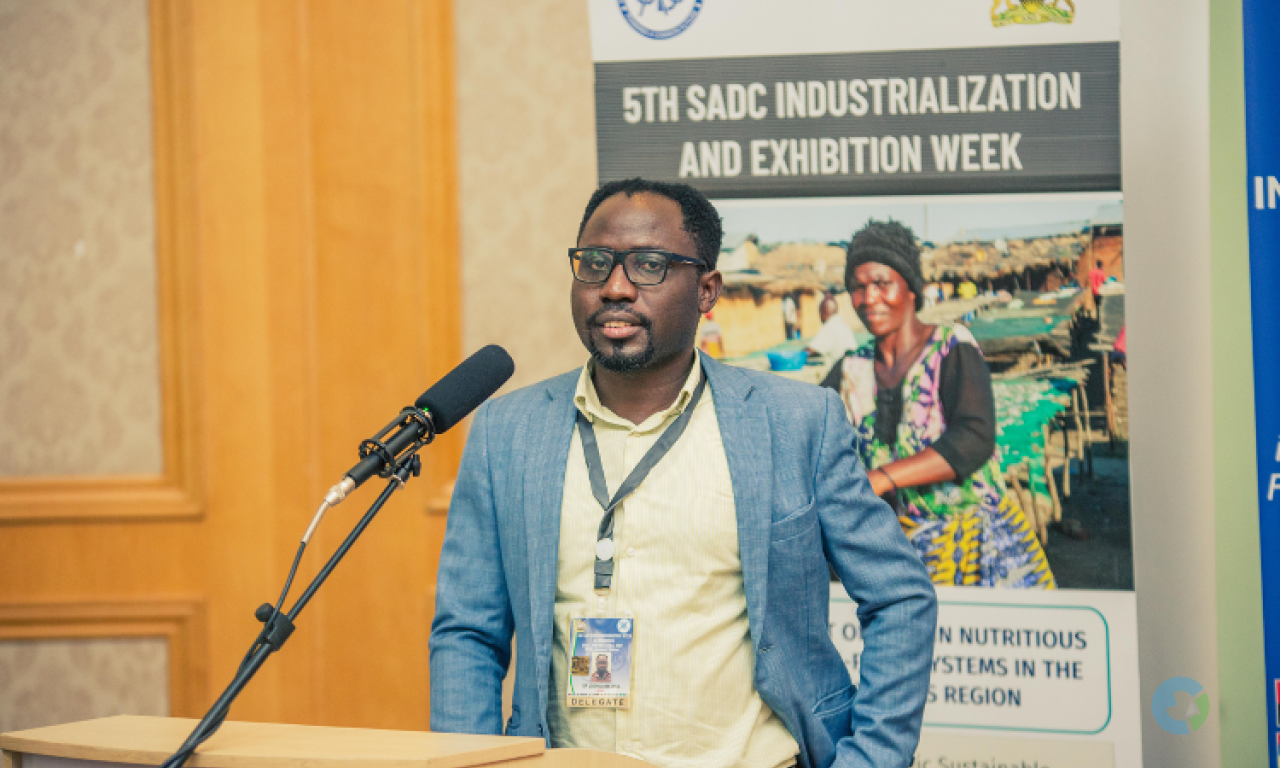
- WorldFish researcher Joshua Wesana explains his work analyzing the relationship between agricultural interventions and their nutritional outcomes
- Wesana argues the need for a more nutrition-sensitive approach to development interventions in order to ensure healthy, sustainable diets are accessible to all
WorldFish and the CGIAR research program on Fish Agri-Food Systems (FISH) are global leaders in aquatic food systems research and innovation, and science and partnerships are the foundation of our work. Our team delivers robust evidence to policymakers and technological innovations to producers, supply chain actors and consumers to transform food systems. In this series, we profile our accomplished scientists in the spotlight.
Joshua Wesana is a senior fellow in Fish and Food Systems Nutritional Outcomes at the Natural Resource Institute, working under the CGIAR Research Program on Fish-Agri Food Systems (FISH) in the small-scale fisheries flagship program. He holds a doctorate in food science and nutrition from Ghent University in Belgium, where he focused on nutrition-sensitive approaches to food systems and adopted a stakeholder-based view of utilizing agri-food supply chains to nourish vulnerable people. Before his doctorate, Joshua pursued two master’s degrees in human nutrition and public health epidemiology focusing on biofortified foods, which contributed to the World Health Organization’s guidelines for using biofortification as a public health strategy.
What are you currently working on in collaboration with WorldFish?
The CGIAR Research Program on Fish-Agri Food Systems (FISH) collaborates with the Natural Resources Institute at the University of Greenwich to deliver research by investing in scientists, and I am one of the senior fellows funded through this partnership. I work in the sustaining small-scale fisheries flagship, focusing on fish in the African Great Lakes Region.
In my role as a Senior Fellow in Fish and Food Systems, I work towards integrating a nutrition lens into programs, policies and investment decisions at multiple levels of the African fish food system. Essentially, I link agricultural interventions to nutritional outcomes and examine their relationship.
What’s the most exciting thing about your research area?
Coming from a human nutrition background, I have found it very fulfilling and exciting to witness how nutrition is increasingly recognized as a multisectoral field, both affecting and affected by other disciplines
There is increased recognition of the role holistic agri-food systems can play in achieving sustainable and healthy diets for everyone. But it’s surprising how the evidence directly linking agriculture with nutrition is only nowadays strongly being advocated, following the realization that agricultural-based interventions were not necessarily improving the nutrition of rural people.
As such, it is thrilling for me to conduct research that contributes to a better understanding of the root causes of malnutrition in all its forms and the potential of novel nutrition-sensitive food system approaches to be part of the solution.
What first sparked your interest in nutrition-sensitive approaches to agriculture?
In 2010, Michael Latham, a nutrition science professor, published an article titled “The Great Vitamin A Fiasco”. This was a recommended reading for a master’s degree class in nutrition disorders that I took at Ghent University in 2013. I was intrigued with the analysis that Latham made regarding the efficacy of providing children with vitamin A capsules or additional supplemental doses.
It became clear to me that nutrition science had been biased towards quick fixes rather than focusing on more sustainable approaches with the potential to sufficiently address the underlying causes of malnutrition. This inspired me to look more into nutrition-sensitive interventions. Hence my first research work focused on biofortification.
Since then, I have looked further and done work on food losses integrated with nutritional losses along the agri-food value chain. And today, I am proud to build on this earlier knowledge on nutrition-sensitive approaches and use it for a better understanding of the role aquatic foods like small pelagic fish play in safeguarding nutritious diets and the livelihoods of people.
What innovation do you think has the greatest potential to improve food and nutrition security in low-income countries?
There are a number of innovations aimed at improving food and nutrition security in low-income countries. However, what I believe is most important is to look if such an innovation is owned by or has an impact on those it’s intended to benefit.
For example, it would be a waste of resources and effort if an innovative small pelagic fish product is developed but is not accessible and affordable for households in low-income countries. Therefore, for any novel food product made from a nutrient-rich food, consideration of affordability should always be a prerequisite for success. It would seem counterproductive if even the minimum healthy diet is out of the reach of many.
How can fish be leveraged to support nutrition and health in rural communities?
For many people in low-income countries, particularly those living close to water bodies, fish is the primary protein source in their diets. It tends to be more available and affordable than other animal-source foods in rural areas and is a widespread traditional food commodity.
It is only today that the role of fish in some regions appears invisible, and local indigenous species are often not prioritized in policies and strategies for nutrition and health.
Small pelagic fish in the African Great Lakes Region are locally abundant, yet they’re often overlooked in nutritional policies or development interventions. Across the region, the silence in policy documents regarding their role in nutrition and health is a stark contrast compared to large commercial species that are perceived to have more economic value. Policies have to explicitly link small fish to health and nutrition and recognize local species alongside more profitable commercial species.
What policy changes are needed to advance these goals?
Integration is key—fisheries and or aquaculture policies can articulate the contribution fish make to better nutrition and health outcomes. The same is true for nutrition or health policies, where fish can be mentioned as a key food to improve these goals.
However, what misses is specificity. Among the available fish species, which ones are highly nutritious, affordable and can reach the most vulnerable people? This is not always clear in policies and a need for explicit articulation is quite overdue. This can be a step towards policy integration. This ought to not only be limited to fisheries/aquaculture and nutrition/health policies but also a consideration of the aspirations of other interconnected policies like agriculture, gender, environment and climate change. With such changes, the role of fish in nutrition and health could potentially become more evident and appreciated especially at the decision-making level.
Which piece of your scientific research are you most proud of and why?
I could mention a number of research outputs, but I can highlight one piece of research that I believe has implications for current and future research and development initiatives. We recently examined the extent to which a subset of the food systems framework has been addressed in recent aquatic food research in the African Great Lakes Region. We identified a number of key aspects of the food environment that have been addressed in aquatic food publications, with availability, physical access, price, affordability and preference drivers standing out most.
However, we noted that previous research has barely applied the food environment lens in the context of the food systems framework, despite touching on some aspects that can be related to the food environment dimensions. Going forward, aquatic foods research in the region can better be anchored within the food systems framework to produce coherent evidence that can sufficiently justify the seemingly invisible contribution of key aquatic foods to nutrition and health in the African Great Lakes Region.
What do you hope your research ultimately achieves?
Once my research and those of colleagues under FISH and similar initiatives reach and are adequately communicated at the policy level, I believe we can make sustainable changes that positively impact the lives of vulnerable women, men and young children in need of nutrient-rich aquatic foods. Ultimately, I want to see that fish, particularly small pelagic fish coming from inland fisheries, become more visible and is better positioned to make its rightful contribution to better nutrition and health outcomes.
Joshua Wesana’s work contributes to the goals of the CGIAR Research Program on Fish Agri-Food Systems (FISH) under its Flagship Program on Sustainable Aquaculture.
